Affordable Housing and the Aged Community in Australia
VerifiedAdded on 2023/06/12
|13
|3586
|491
Report
AI Summary
This report investigates the challenges in affordable housing for the aged community in Australia, focusing on the experiences of older individuals dependent on Assistance with Care and Housing for the Aged (ACHA). It highlights the increasing aged population and the impact of the private rental market on homelessness among the elderly. The study aims to understand the trend of affordable housing, document the experiences of the aged population availing these benefits, and assess factors contributing to housing insecurity. Through qualitative research, including unstructured questionnaires and interviews with entrepreneurs in elderly care, the report explores the unique needs of older homeless individuals, the limitations of current policies, and the factors associated with accessing housing security. The findings provide valuable insights for government agencies in formulating intervention policies to address older homelessness in Australia.
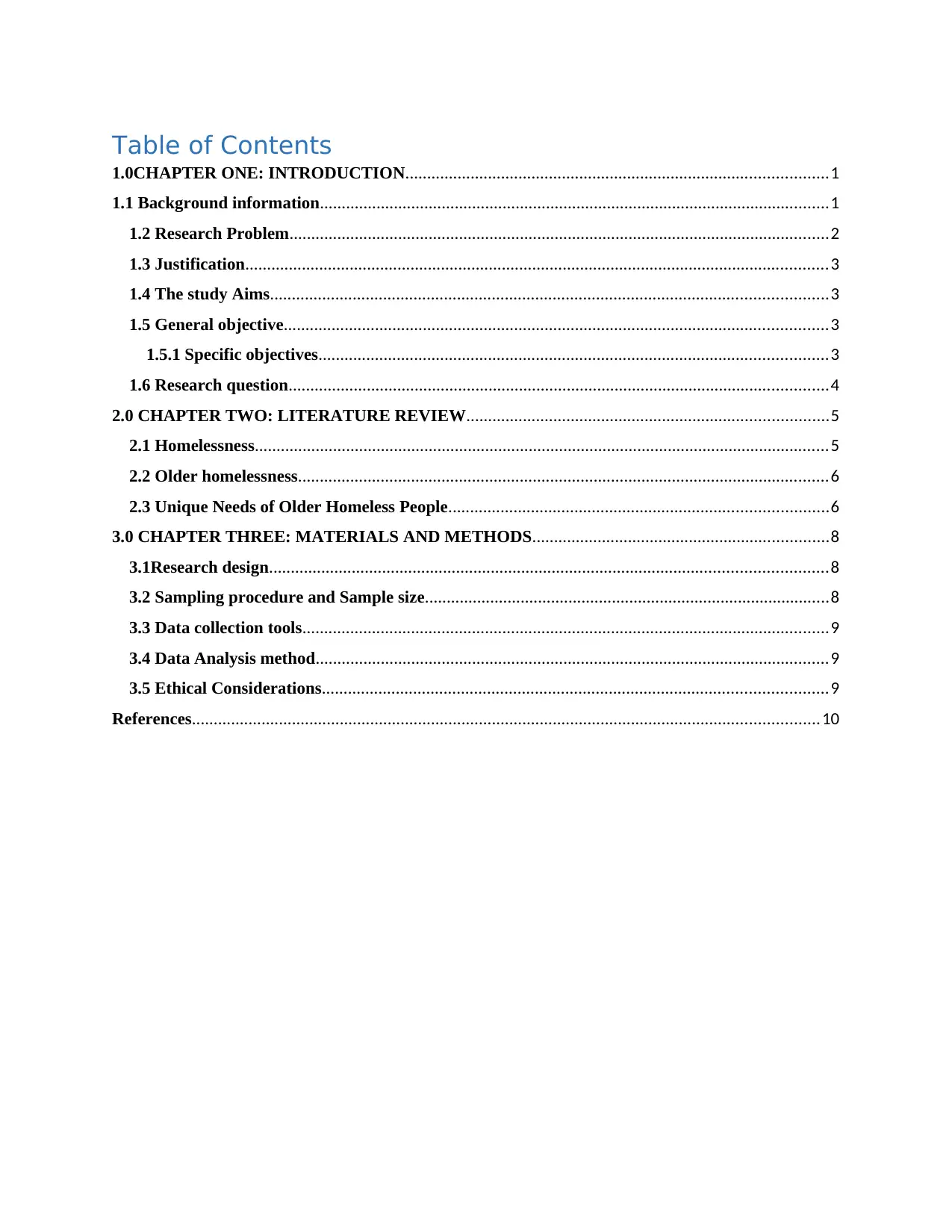
Table of Contents
1.0CHAPTER ONE: INTRODUCTION.................................................................................................1
1.1 Background information.....................................................................................................................1
1.2 Research Problem............................................................................................................................2
1.3 Justification......................................................................................................................................3
1.4 The study Aims................................................................................................................................3
1.5 General objective.............................................................................................................................3
1.5.1 Specific objectives.....................................................................................................................3
1.6 Research question............................................................................................................................4
2.0 CHAPTER TWO: LITERATURE REVIEW...................................................................................5
2.1 Homelessness....................................................................................................................................5
2.2 Older homelessness..........................................................................................................................6
2.3 Unique Needs of Older Homeless People.......................................................................................6
3.0 CHAPTER THREE: MATERIALS AND METHODS....................................................................8
3.1Research design................................................................................................................................8
3.2 Sampling procedure and Sample size.............................................................................................8
3.3 Data collection tools.........................................................................................................................9
3.4 Data Analysis method......................................................................................................................9
3.5 Ethical Considerations....................................................................................................................9
References................................................................................................................................................10
1.0CHAPTER ONE: INTRODUCTION.................................................................................................1
1.1 Background information.....................................................................................................................1
1.2 Research Problem............................................................................................................................2
1.3 Justification......................................................................................................................................3
1.4 The study Aims................................................................................................................................3
1.5 General objective.............................................................................................................................3
1.5.1 Specific objectives.....................................................................................................................3
1.6 Research question............................................................................................................................4
2.0 CHAPTER TWO: LITERATURE REVIEW...................................................................................5
2.1 Homelessness....................................................................................................................................5
2.2 Older homelessness..........................................................................................................................6
2.3 Unique Needs of Older Homeless People.......................................................................................6
3.0 CHAPTER THREE: MATERIALS AND METHODS....................................................................8
3.1Research design................................................................................................................................8
3.2 Sampling procedure and Sample size.............................................................................................8
3.3 Data collection tools.........................................................................................................................9
3.4 Data Analysis method......................................................................................................................9
3.5 Ethical Considerations....................................................................................................................9
References................................................................................................................................................10
Paraphrase This Document
Need a fresh take? Get an instant paraphrase of this document with our AI Paraphraser
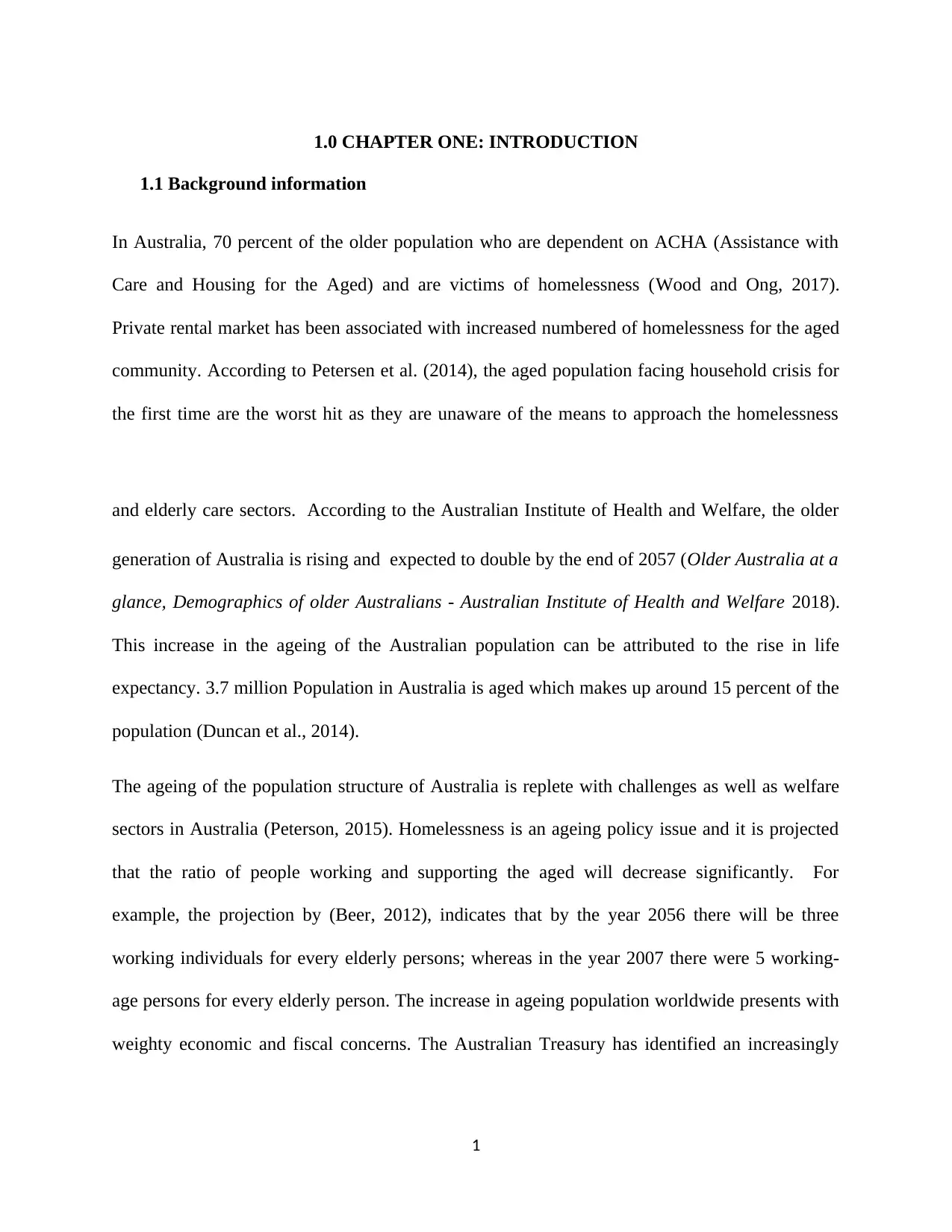
1.0 CHAPTER ONE: INTRODUCTION
1.1 Background information
In Australia, 70 percent of the older population who are dependent on ACHA (Assistance with
Care and Housing for the Aged) and are victims of homelessness (Wood and Ong, 2017).
Private rental market has been associated with increased numbered of homelessness for the aged
community. According to Petersen et al. (2014), the aged population facing household crisis for
the first time are the worst hit as they are unaware of the means to approach the homelessness
and elderly care sectors. According to the Australian Institute of Health and Welfare, the older
generation of Australia is rising and expected to double by the end of 2057 (Older Australia at a
glance, Demographics of older Australians - Australian Institute of Health and Welfare 2018).
This increase in the ageing of the Australian population can be attributed to the rise in life
expectancy. 3.7 million Population in Australia is aged which makes up around 15 percent of the
population (Duncan et al., 2014).
The ageing of the population structure of Australia is replete with challenges as well as welfare
sectors in Australia (Peterson, 2015). Homelessness is an ageing policy issue and it is projected
that the ratio of people working and supporting the aged will decrease significantly. For
example, the projection by (Beer, 2012), indicates that by the year 2056 there will be three
working individuals for every elderly persons; whereas in the year 2007 there were 5 working-
age persons for every elderly person. The increase in ageing population worldwide presents with
weighty economic and fiscal concerns. The Australian Treasury has identified an increasingly
1
1.1 Background information
In Australia, 70 percent of the older population who are dependent on ACHA (Assistance with
Care and Housing for the Aged) and are victims of homelessness (Wood and Ong, 2017).
Private rental market has been associated with increased numbered of homelessness for the aged
community. According to Petersen et al. (2014), the aged population facing household crisis for
the first time are the worst hit as they are unaware of the means to approach the homelessness
and elderly care sectors. According to the Australian Institute of Health and Welfare, the older
generation of Australia is rising and expected to double by the end of 2057 (Older Australia at a
glance, Demographics of older Australians - Australian Institute of Health and Welfare 2018).
This increase in the ageing of the Australian population can be attributed to the rise in life
expectancy. 3.7 million Population in Australia is aged which makes up around 15 percent of the
population (Duncan et al., 2014).
The ageing of the population structure of Australia is replete with challenges as well as welfare
sectors in Australia (Peterson, 2015). Homelessness is an ageing policy issue and it is projected
that the ratio of people working and supporting the aged will decrease significantly. For
example, the projection by (Beer, 2012), indicates that by the year 2056 there will be three
working individuals for every elderly persons; whereas in the year 2007 there were 5 working-
age persons for every elderly person. The increase in ageing population worldwide presents with
weighty economic and fiscal concerns. The Australian Treasury has identified an increasingly
1
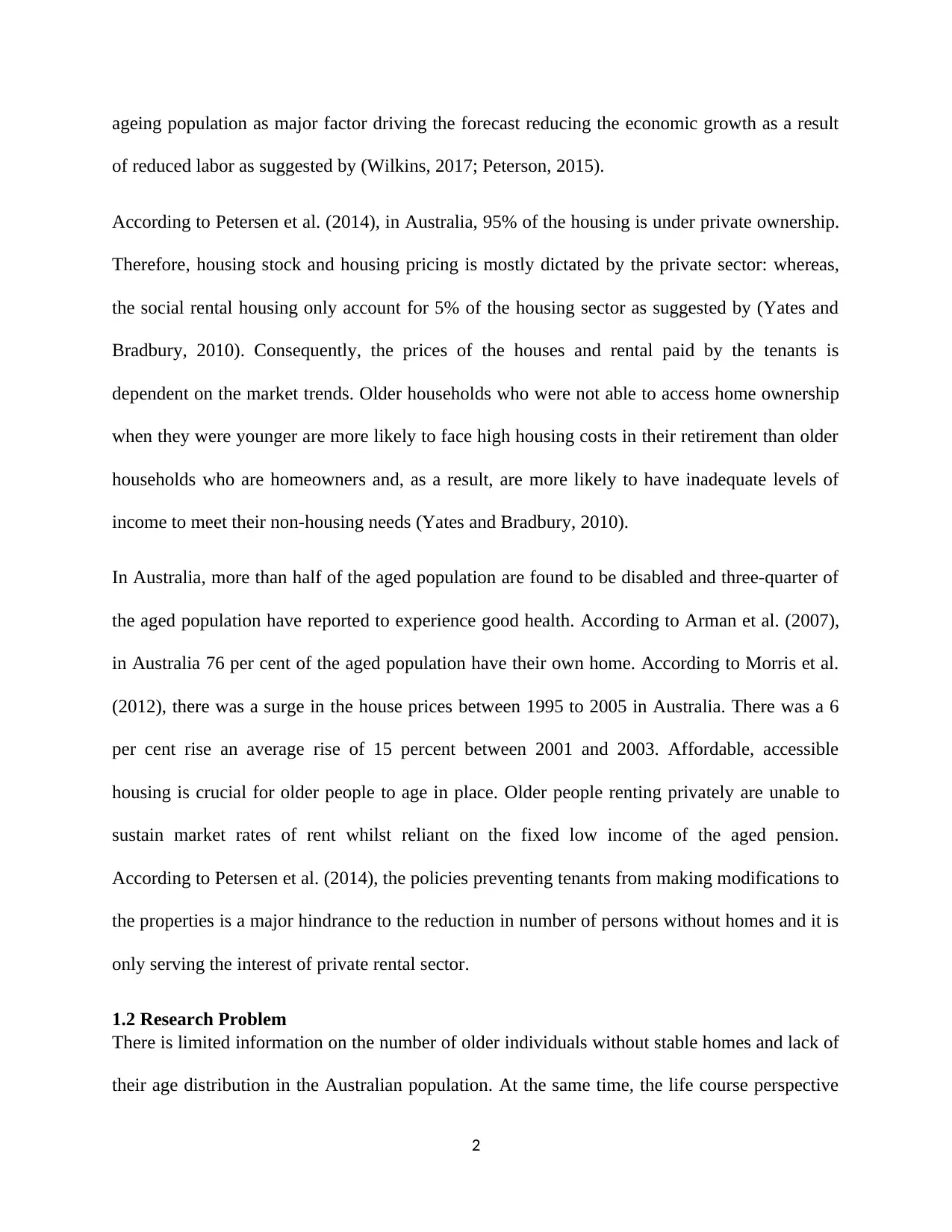
ageing population as major factor driving the forecast reducing the economic growth as a result
of reduced labor as suggested by (Wilkins, 2017; Peterson, 2015).
According to Petersen et al. (2014), in Australia, 95% of the housing is under private ownership.
Therefore, housing stock and housing pricing is mostly dictated by the private sector: whereas,
the social rental housing only account for 5% of the housing sector as suggested by (Yates and
Bradbury, 2010). Consequently, the prices of the houses and rental paid by the tenants is
dependent on the market trends. Older households who were not able to access home ownership
when they were younger are more likely to face high housing costs in their retirement than older
households who are homeowners and, as a result, are more likely to have inadequate levels of
income to meet their non-housing needs (Yates and Bradbury, 2010).
In Australia, more than half of the aged population are found to be disabled and three-quarter of
the aged population have reported to experience good health. According to Arman et al. (2007),
in Australia 76 per cent of the aged population have their own home. According to Morris et al.
(2012), there was a surge in the house prices between 1995 to 2005 in Australia. There was a 6
per cent rise an average rise of 15 percent between 2001 and 2003. Affordable, accessible
housing is crucial for older people to age in place. Older people renting privately are unable to
sustain market rates of rent whilst reliant on the fixed low income of the aged pension.
According to Petersen et al. (2014), the policies preventing tenants from making modifications to
the properties is a major hindrance to the reduction in number of persons without homes and it is
only serving the interest of private rental sector.
1.2 Research Problem
There is limited information on the number of older individuals without stable homes and lack of
their age distribution in the Australian population. At the same time, the life course perspective
2
of reduced labor as suggested by (Wilkins, 2017; Peterson, 2015).
According to Petersen et al. (2014), in Australia, 95% of the housing is under private ownership.
Therefore, housing stock and housing pricing is mostly dictated by the private sector: whereas,
the social rental housing only account for 5% of the housing sector as suggested by (Yates and
Bradbury, 2010). Consequently, the prices of the houses and rental paid by the tenants is
dependent on the market trends. Older households who were not able to access home ownership
when they were younger are more likely to face high housing costs in their retirement than older
households who are homeowners and, as a result, are more likely to have inadequate levels of
income to meet their non-housing needs (Yates and Bradbury, 2010).
In Australia, more than half of the aged population are found to be disabled and three-quarter of
the aged population have reported to experience good health. According to Arman et al. (2007),
in Australia 76 per cent of the aged population have their own home. According to Morris et al.
(2012), there was a surge in the house prices between 1995 to 2005 in Australia. There was a 6
per cent rise an average rise of 15 percent between 2001 and 2003. Affordable, accessible
housing is crucial for older people to age in place. Older people renting privately are unable to
sustain market rates of rent whilst reliant on the fixed low income of the aged pension.
According to Petersen et al. (2014), the policies preventing tenants from making modifications to
the properties is a major hindrance to the reduction in number of persons without homes and it is
only serving the interest of private rental sector.
1.2 Research Problem
There is limited information on the number of older individuals without stable homes and lack of
their age distribution in the Australian population. At the same time, the life course perspective
2
⊘ This is a preview!⊘
Do you want full access?
Subscribe today to unlock all pages.

Trusted by 1+ million students worldwide

has not been well studied and documented and its application on realization main pathways
resulting to homelessness, particularly risk factors and cause events, and their prevalence across
the life course. Most researchers have focused on gender and without putting into considerations
their ethnicity. Furthermore, the study have not considered the impact of multiple marginalized
categories on older homeless adult’s experiences and challenges faced which is very necessary.
1.3 Justification
The findings from this study will provide more information on the experiences and challenges of
the aged population who have availed the benefits of affordable housing. Hence, such
information will be of benefit to the government agencies when formulating intervention policies
around older homelessness. The findings from the interview with entrepreneurs will be enriching
for understanding the scenario of affordable housing in Australia.
1.4 The study Aims
The aim of this study is to understand the trend of affordable housing for the aged in Australia. It
also intends to document the experiences of the aged population who have availed the benefits of
affordable housing and investigate their lived experiences. The interview with entrepreneurs is
believed to be enriching for understanding the scenario of affordable housing in Australia.
1.5 General objective
To assess the challenges which older individuals face around housing security and whether any
factors are common among women and men which may contribute to a lack of housing security.
1.5.1 Specific objectives
1. To determine factors associated with affordable housing for the aged community
3
resulting to homelessness, particularly risk factors and cause events, and their prevalence across
the life course. Most researchers have focused on gender and without putting into considerations
their ethnicity. Furthermore, the study have not considered the impact of multiple marginalized
categories on older homeless adult’s experiences and challenges faced which is very necessary.
1.3 Justification
The findings from this study will provide more information on the experiences and challenges of
the aged population who have availed the benefits of affordable housing. Hence, such
information will be of benefit to the government agencies when formulating intervention policies
around older homelessness. The findings from the interview with entrepreneurs will be enriching
for understanding the scenario of affordable housing in Australia.
1.4 The study Aims
The aim of this study is to understand the trend of affordable housing for the aged in Australia. It
also intends to document the experiences of the aged population who have availed the benefits of
affordable housing and investigate their lived experiences. The interview with entrepreneurs is
believed to be enriching for understanding the scenario of affordable housing in Australia.
1.5 General objective
To assess the challenges which older individuals face around housing security and whether any
factors are common among women and men which may contribute to a lack of housing security.
1.5.1 Specific objectives
1. To determine factors associated with affordable housing for the aged community
3
Paraphrase This Document
Need a fresh take? Get an instant paraphrase of this document with our AI Paraphraser
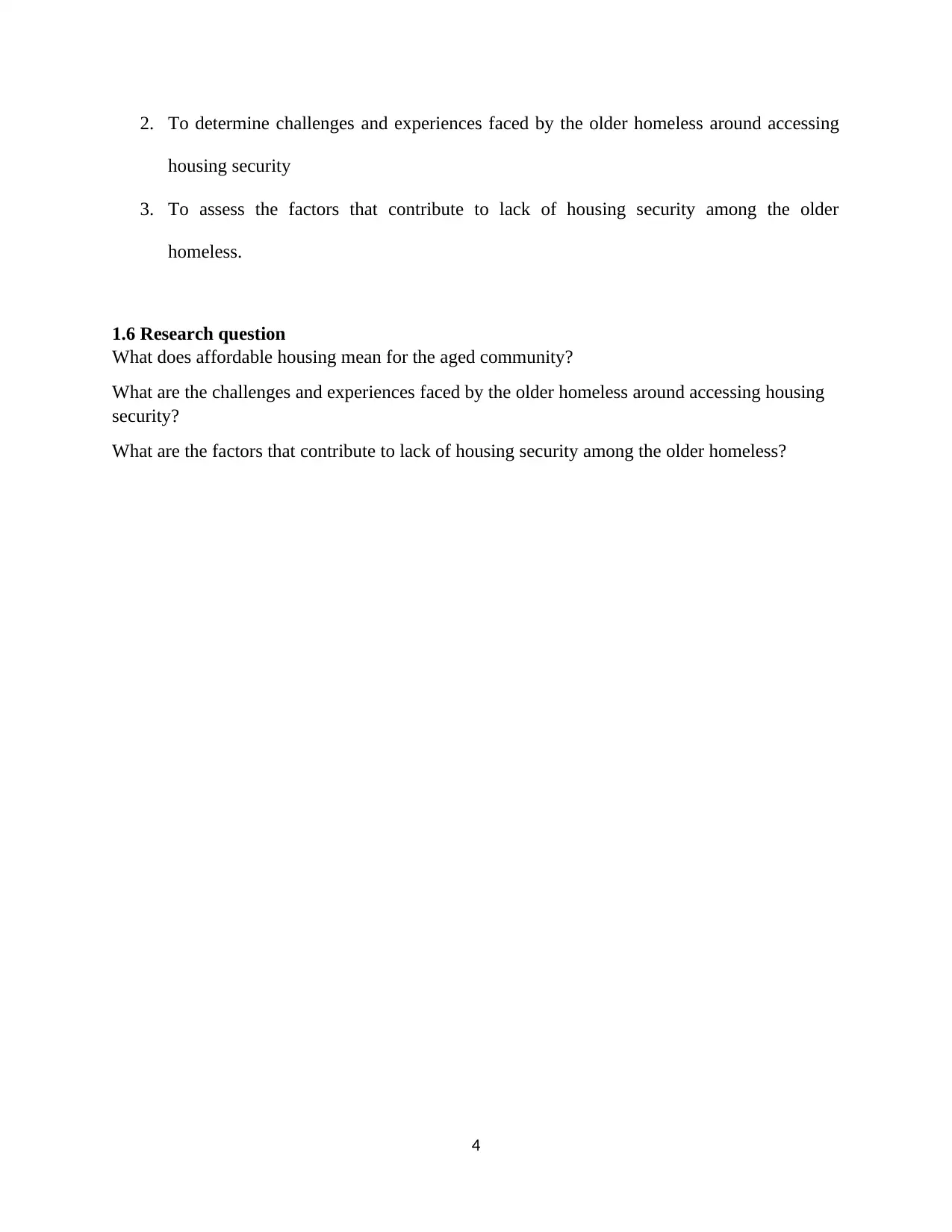
2. To determine challenges and experiences faced by the older homeless around accessing
housing security
3. To assess the factors that contribute to lack of housing security among the older
homeless.
1.6 Research question
What does affordable housing mean for the aged community?
What are the challenges and experiences faced by the older homeless around accessing housing
security?
What are the factors that contribute to lack of housing security among the older homeless?
4
housing security
3. To assess the factors that contribute to lack of housing security among the older
homeless.
1.6 Research question
What does affordable housing mean for the aged community?
What are the challenges and experiences faced by the older homeless around accessing housing
security?
What are the factors that contribute to lack of housing security among the older homeless?
4

2.0 CHAPTER TWO: LITERATURE REVIEW
2.1 Homelessness
According to the Canadian Homelessness Research Network (2012), homelessness is defined as
a situation of a family without stable, permanent appropriate housing. Moreover homelessness
can be identified by four living circumstances including Unsheltered individuals living in the
street or in places that are not fit for human tenancy; Individuals under emergency settlement
referring to persons occupying overnight shelters for persons who are without homes this include
also individuals who are affected by family violence; Individuals settled under provisional
accommodation these are persons who lack security of tenure and are temporarily settled; lastly
persons at risk of homelessness these are individuals whose housing situation doesn’t meet
public health and safety standards as suggested by (Grenier, 2016). According to Mott et al.
(2012), the typical homelessness if characterized by someone living in the streets or in
government shelters, therefore it is difficult to identify individuals living in provisional shelters
and the persons at-risk because such persons may fail to use services as shelters which are mostly
associated to homelessness.
Researchers have clearly defined different types of homelessness including transitional,
temporary, episodic, and chronic homelessness as suggested by (Culhane and Metraux, 2008;
Echenberg and Jensen, 2008).In fact, persons who are without home s for three months have
been categorized as chronic homelessness as suggested by (Gonyea, 2010), whereas other
researchers defines individuals categorized as chronic homelessness as persons who are
continually without homes for more than a year (McDonald et al., 2009). Individuals in the
5
2.1 Homelessness
According to the Canadian Homelessness Research Network (2012), homelessness is defined as
a situation of a family without stable, permanent appropriate housing. Moreover homelessness
can be identified by four living circumstances including Unsheltered individuals living in the
street or in places that are not fit for human tenancy; Individuals under emergency settlement
referring to persons occupying overnight shelters for persons who are without homes this include
also individuals who are affected by family violence; Individuals settled under provisional
accommodation these are persons who lack security of tenure and are temporarily settled; lastly
persons at risk of homelessness these are individuals whose housing situation doesn’t meet
public health and safety standards as suggested by (Grenier, 2016). According to Mott et al.
(2012), the typical homelessness if characterized by someone living in the streets or in
government shelters, therefore it is difficult to identify individuals living in provisional shelters
and the persons at-risk because such persons may fail to use services as shelters which are mostly
associated to homelessness.
Researchers have clearly defined different types of homelessness including transitional,
temporary, episodic, and chronic homelessness as suggested by (Culhane and Metraux, 2008;
Echenberg and Jensen, 2008).In fact, persons who are without home s for three months have
been categorized as chronic homelessness as suggested by (Gonyea, 2010), whereas other
researchers defines individuals categorized as chronic homelessness as persons who are
continually without homes for more than a year (McDonald et al., 2009). Individuals in the
5
⊘ This is a preview!⊘
Do you want full access?
Subscribe today to unlock all pages.

Trusted by 1+ million students worldwide
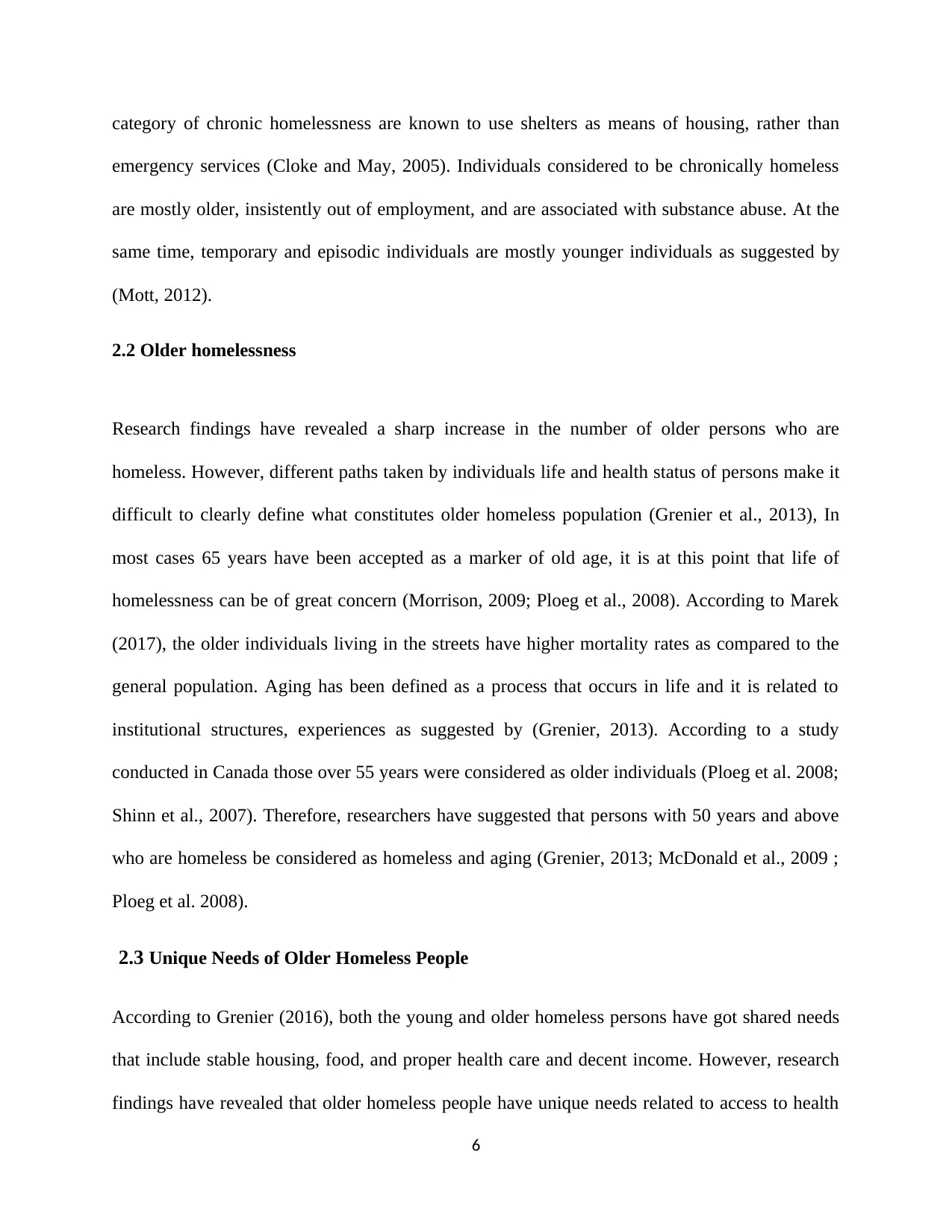
category of chronic homelessness are known to use shelters as means of housing, rather than
emergency services (Cloke and May, 2005). Individuals considered to be chronically homeless
are mostly older, insistently out of employment, and are associated with substance abuse. At the
same time, temporary and episodic individuals are mostly younger individuals as suggested by
(Mott, 2012).
2.2 Older homelessness
Research findings have revealed a sharp increase in the number of older persons who are
homeless. However, different paths taken by individuals life and health status of persons make it
difficult to clearly define what constitutes older homeless population (Grenier et al., 2013), In
most cases 65 years have been accepted as a marker of old age, it is at this point that life of
homelessness can be of great concern (Morrison, 2009; Ploeg et al., 2008). According to Marek
(2017), the older individuals living in the streets have higher mortality rates as compared to the
general population. Aging has been defined as a process that occurs in life and it is related to
institutional structures, experiences as suggested by (Grenier, 2013). According to a study
conducted in Canada those over 55 years were considered as older individuals (Ploeg et al. 2008;
Shinn et al., 2007). Therefore, researchers have suggested that persons with 50 years and above
who are homeless be considered as homeless and aging (Grenier, 2013; McDonald et al., 2009 ;
Ploeg et al. 2008).
2.3 Unique Needs of Older Homeless People
According to Grenier (2016), both the young and older homeless persons have got shared needs
that include stable housing, food, and proper health care and decent income. However, research
findings have revealed that older homeless people have unique needs related to access to health
6
emergency services (Cloke and May, 2005). Individuals considered to be chronically homeless
are mostly older, insistently out of employment, and are associated with substance abuse. At the
same time, temporary and episodic individuals are mostly younger individuals as suggested by
(Mott, 2012).
2.2 Older homelessness
Research findings have revealed a sharp increase in the number of older persons who are
homeless. However, different paths taken by individuals life and health status of persons make it
difficult to clearly define what constitutes older homeless population (Grenier et al., 2013), In
most cases 65 years have been accepted as a marker of old age, it is at this point that life of
homelessness can be of great concern (Morrison, 2009; Ploeg et al., 2008). According to Marek
(2017), the older individuals living in the streets have higher mortality rates as compared to the
general population. Aging has been defined as a process that occurs in life and it is related to
institutional structures, experiences as suggested by (Grenier, 2013). According to a study
conducted in Canada those over 55 years were considered as older individuals (Ploeg et al. 2008;
Shinn et al., 2007). Therefore, researchers have suggested that persons with 50 years and above
who are homeless be considered as homeless and aging (Grenier, 2013; McDonald et al., 2009 ;
Ploeg et al. 2008).
2.3 Unique Needs of Older Homeless People
According to Grenier (2016), both the young and older homeless persons have got shared needs
that include stable housing, food, and proper health care and decent income. However, research
findings have revealed that older homeless people have unique needs related to access to health
6
Paraphrase This Document
Need a fresh take? Get an instant paraphrase of this document with our AI Paraphraser

care and social services (Morris et al., 2012). According to Marek (2017), individuals who have
an advanced age and are homeless have high risk of developing mental health problems.
Therefore, they require more specialized medical care beyond what can be provided by the
shelters as suggested by (Minnery and Greenhalgh, 2007). Being homeless at an advanced age
has been revealed to be quite challenging making provision of housing for the elderly an urgent
thing (Grenier, 2013). Stigmatization and discrimination of older homeless individuals have been
reported in healthcare facilities, hence, the need for sensitization of medicals staff on the issues
around older homeless persons (Morris et al., 2012; Lipmann, 2009;).At the same time,
researchers have revealed that older homeless persons in some instances fails to access housing
and support services due to difficulties in navigating government services (Ploeg et al., 2008).
For example, in Canada, Concerns have been raised about the appropriateness of services that are
accessible for the older homeless people (McDonald et al., 2009).
7
an advanced age and are homeless have high risk of developing mental health problems.
Therefore, they require more specialized medical care beyond what can be provided by the
shelters as suggested by (Minnery and Greenhalgh, 2007). Being homeless at an advanced age
has been revealed to be quite challenging making provision of housing for the elderly an urgent
thing (Grenier, 2013). Stigmatization and discrimination of older homeless individuals have been
reported in healthcare facilities, hence, the need for sensitization of medicals staff on the issues
around older homeless persons (Morris et al., 2012; Lipmann, 2009;).At the same time,
researchers have revealed that older homeless persons in some instances fails to access housing
and support services due to difficulties in navigating government services (Ploeg et al., 2008).
For example, in Canada, Concerns have been raised about the appropriateness of services that are
accessible for the older homeless people (McDonald et al., 2009).
7
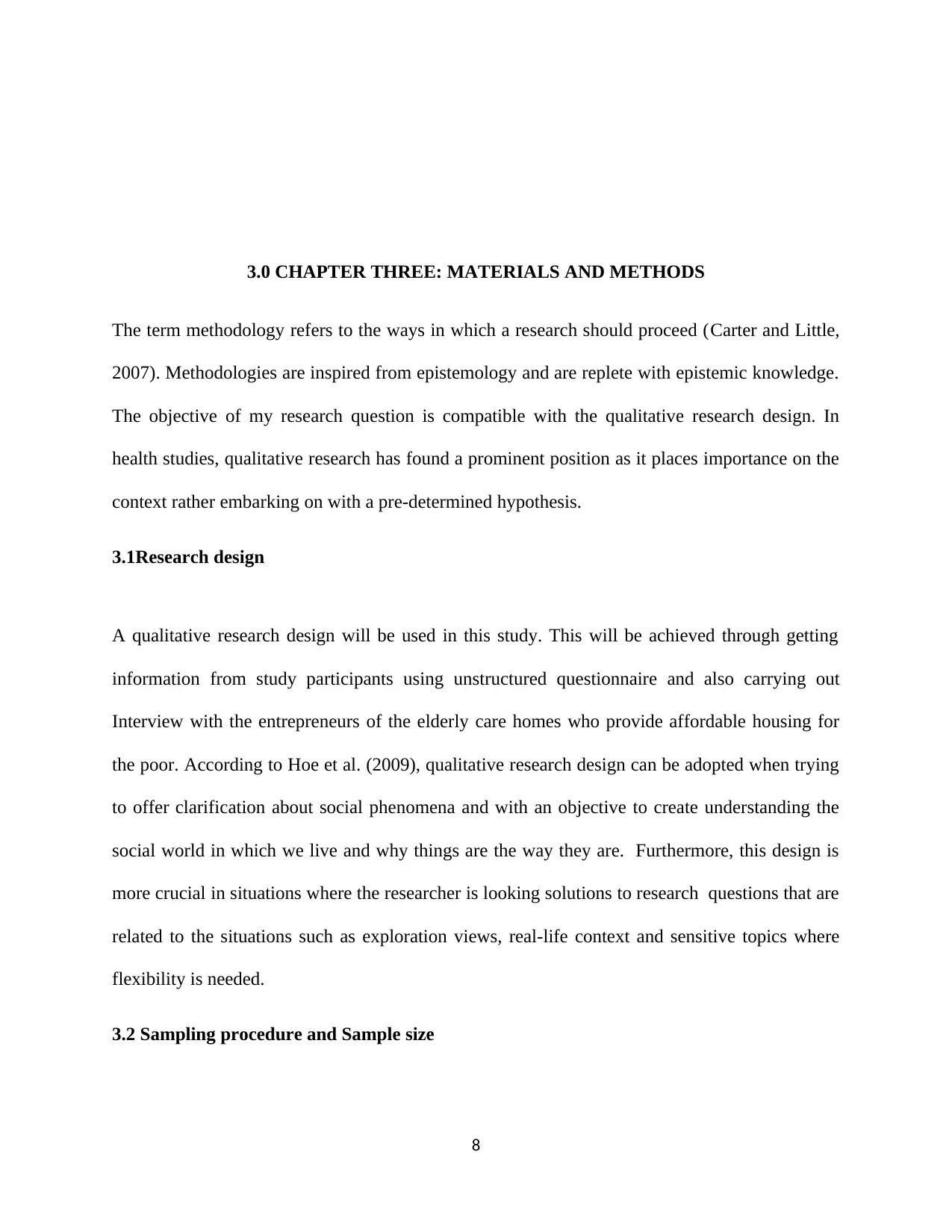
3.0 CHAPTER THREE: MATERIALS AND METHODS
The term methodology refers to the ways in which a research should proceed (Carter and Little,
2007). Methodologies are inspired from epistemology and are replete with epistemic knowledge.
The objective of my research question is compatible with the qualitative research design. In
health studies, qualitative research has found a prominent position as it places importance on the
context rather embarking on with a pre-determined hypothesis.
3.1Research design
A qualitative research design will be used in this study. This will be achieved through getting
information from study participants using unstructured questionnaire and also carrying out
Interview with the entrepreneurs of the elderly care homes who provide affordable housing for
the poor. According to Hoe et al. (2009), qualitative research design can be adopted when trying
to offer clarification about social phenomena and with an objective to create understanding the
social world in which we live and why things are the way they are. Furthermore, this design is
more crucial in situations where the researcher is looking solutions to research questions that are
related to the situations such as exploration views, real-life context and sensitive topics where
flexibility is needed.
3.2 Sampling procedure and Sample size
8
The term methodology refers to the ways in which a research should proceed (Carter and Little,
2007). Methodologies are inspired from epistemology and are replete with epistemic knowledge.
The objective of my research question is compatible with the qualitative research design. In
health studies, qualitative research has found a prominent position as it places importance on the
context rather embarking on with a pre-determined hypothesis.
3.1Research design
A qualitative research design will be used in this study. This will be achieved through getting
information from study participants using unstructured questionnaire and also carrying out
Interview with the entrepreneurs of the elderly care homes who provide affordable housing for
the poor. According to Hoe et al. (2009), qualitative research design can be adopted when trying
to offer clarification about social phenomena and with an objective to create understanding the
social world in which we live and why things are the way they are. Furthermore, this design is
more crucial in situations where the researcher is looking solutions to research questions that are
related to the situations such as exploration views, real-life context and sensitive topics where
flexibility is needed.
3.2 Sampling procedure and Sample size
8
⊘ This is a preview!⊘
Do you want full access?
Subscribe today to unlock all pages.

Trusted by 1+ million students worldwide
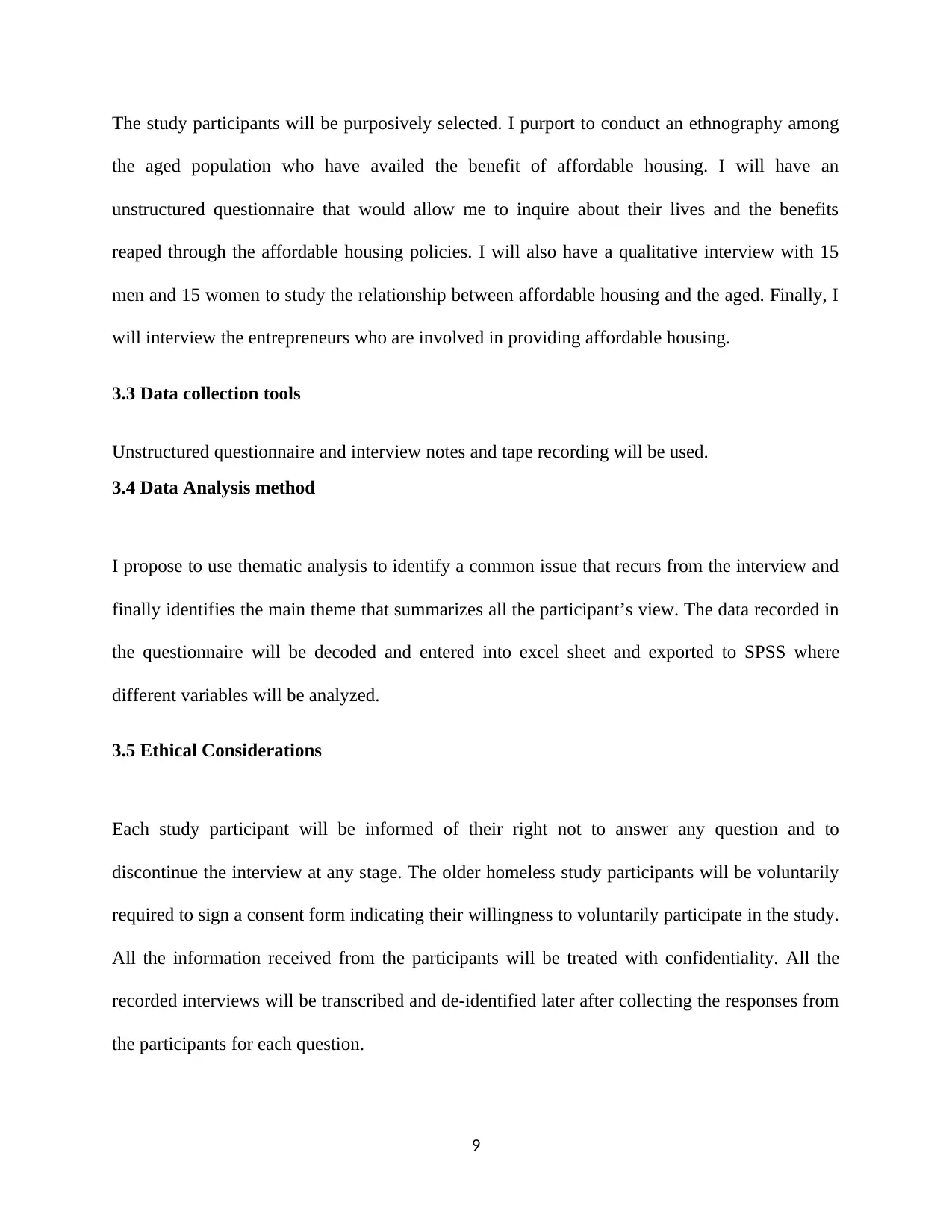
The study participants will be purposively selected. I purport to conduct an ethnography among
the aged population who have availed the benefit of affordable housing. I will have an
unstructured questionnaire that would allow me to inquire about their lives and the benefits
reaped through the affordable housing policies. I will also have a qualitative interview with 15
men and 15 women to study the relationship between affordable housing and the aged. Finally, I
will interview the entrepreneurs who are involved in providing affordable housing.
3.3 Data collection tools
Unstructured questionnaire and interview notes and tape recording will be used.
3.4 Data Analysis method
I propose to use thematic analysis to identify a common issue that recurs from the interview and
finally identifies the main theme that summarizes all the participant’s view. The data recorded in
the questionnaire will be decoded and entered into excel sheet and exported to SPSS where
different variables will be analyzed.
3.5 Ethical Considerations
Each study participant will be informed of their right not to answer any question and to
discontinue the interview at any stage. The older homeless study participants will be voluntarily
required to sign a consent form indicating their willingness to voluntarily participate in the study.
All the information received from the participants will be treated with confidentiality. All the
recorded interviews will be transcribed and de-identified later after collecting the responses from
the participants for each question.
9
the aged population who have availed the benefit of affordable housing. I will have an
unstructured questionnaire that would allow me to inquire about their lives and the benefits
reaped through the affordable housing policies. I will also have a qualitative interview with 15
men and 15 women to study the relationship between affordable housing and the aged. Finally, I
will interview the entrepreneurs who are involved in providing affordable housing.
3.3 Data collection tools
Unstructured questionnaire and interview notes and tape recording will be used.
3.4 Data Analysis method
I propose to use thematic analysis to identify a common issue that recurs from the interview and
finally identifies the main theme that summarizes all the participant’s view. The data recorded in
the questionnaire will be decoded and entered into excel sheet and exported to SPSS where
different variables will be analyzed.
3.5 Ethical Considerations
Each study participant will be informed of their right not to answer any question and to
discontinue the interview at any stage. The older homeless study participants will be voluntarily
required to sign a consent form indicating their willingness to voluntarily participate in the study.
All the information received from the participants will be treated with confidentiality. All the
recorded interviews will be transcribed and de-identified later after collecting the responses from
the participants for each question.
9
Paraphrase This Document
Need a fresh take? Get an instant paraphrase of this document with our AI Paraphraser
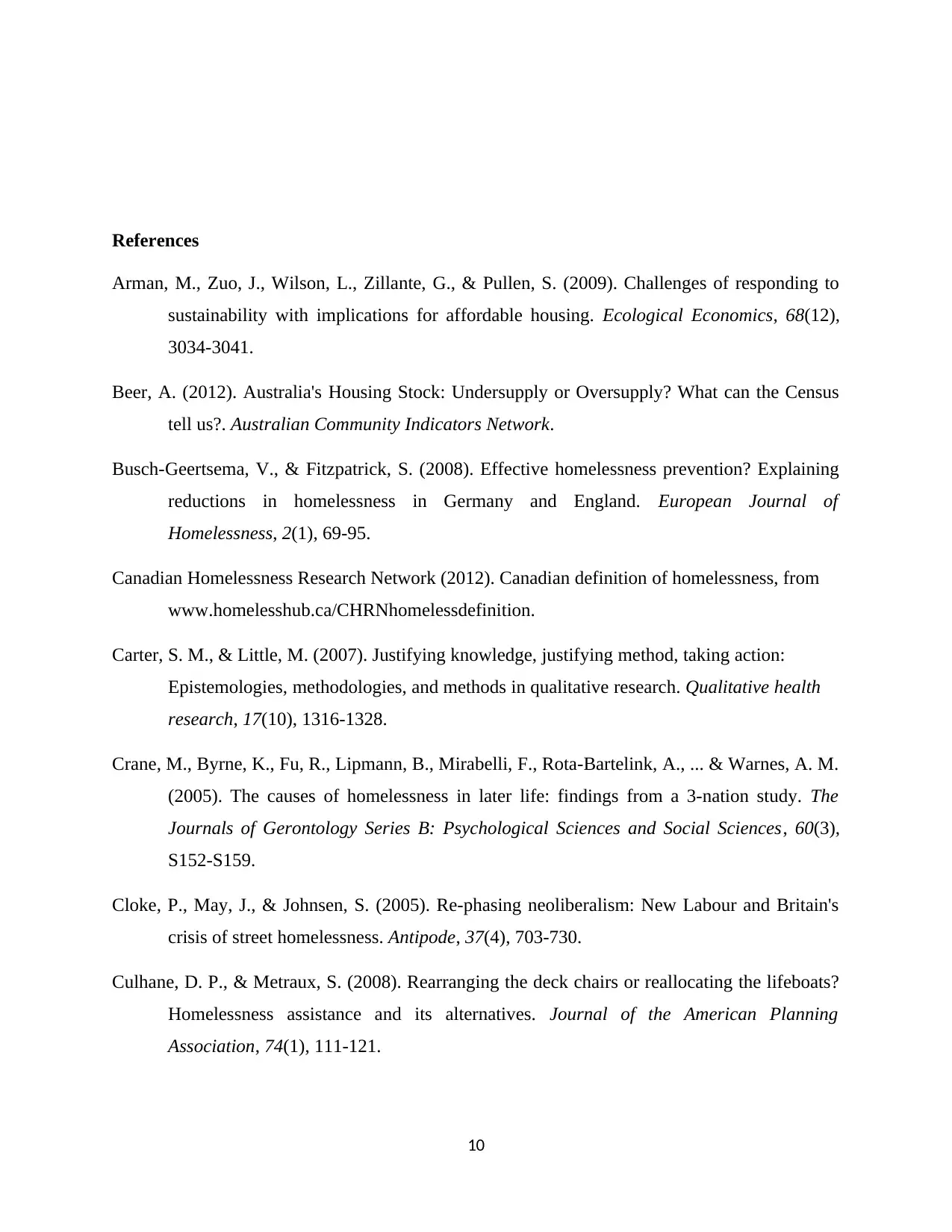
References
Arman, M., Zuo, J., Wilson, L., Zillante, G., & Pullen, S. (2009). Challenges of responding to
sustainability with implications for affordable housing. Ecological Economics, 68(12),
3034-3041.
Beer, A. (2012). Australia's Housing Stock: Undersupply or Oversupply? What can the Census
tell us?. Australian Community Indicators Network.
Busch-Geertsema, V., & Fitzpatrick, S. (2008). Effective homelessness prevention? Explaining
reductions in homelessness in Germany and England. European Journal of
Homelessness, 2(1), 69-95.
Canadian Homelessness Research Network (2012). Canadian definition of homelessness, from
www.homelesshub.ca/CHRNhomelessdefinition.
Carter, S. M., & Little, M. (2007). Justifying knowledge, justifying method, taking action:
Epistemologies, methodologies, and methods in qualitative research. Qualitative health
research, 17(10), 1316-1328.
Crane, M., Byrne, K., Fu, R., Lipmann, B., Mirabelli, F., Rota-Bartelink, A., ... & Warnes, A. M.
(2005). The causes of homelessness in later life: findings from a 3-nation study. The
Journals of Gerontology Series B: Psychological Sciences and Social Sciences, 60(3),
S152-S159.
Cloke, P., May, J., & Johnsen, S. (2005). Re‐phasing neoliberalism: New Labour and Britain's
crisis of street homelessness. Antipode, 37(4), 703-730.
Culhane, D. P., & Metraux, S. (2008). Rearranging the deck chairs or reallocating the lifeboats?
Homelessness assistance and its alternatives. Journal of the American Planning
Association, 74(1), 111-121.
10
Arman, M., Zuo, J., Wilson, L., Zillante, G., & Pullen, S. (2009). Challenges of responding to
sustainability with implications for affordable housing. Ecological Economics, 68(12),
3034-3041.
Beer, A. (2012). Australia's Housing Stock: Undersupply or Oversupply? What can the Census
tell us?. Australian Community Indicators Network.
Busch-Geertsema, V., & Fitzpatrick, S. (2008). Effective homelessness prevention? Explaining
reductions in homelessness in Germany and England. European Journal of
Homelessness, 2(1), 69-95.
Canadian Homelessness Research Network (2012). Canadian definition of homelessness, from
www.homelesshub.ca/CHRNhomelessdefinition.
Carter, S. M., & Little, M. (2007). Justifying knowledge, justifying method, taking action:
Epistemologies, methodologies, and methods in qualitative research. Qualitative health
research, 17(10), 1316-1328.
Crane, M., Byrne, K., Fu, R., Lipmann, B., Mirabelli, F., Rota-Bartelink, A., ... & Warnes, A. M.
(2005). The causes of homelessness in later life: findings from a 3-nation study. The
Journals of Gerontology Series B: Psychological Sciences and Social Sciences, 60(3),
S152-S159.
Cloke, P., May, J., & Johnsen, S. (2005). Re‐phasing neoliberalism: New Labour and Britain's
crisis of street homelessness. Antipode, 37(4), 703-730.
Culhane, D. P., & Metraux, S. (2008). Rearranging the deck chairs or reallocating the lifeboats?
Homelessness assistance and its alternatives. Journal of the American Planning
Association, 74(1), 111-121.
10

Duncan, A. S., James, A., Leong, K., Ong, R., & Rowley, S. (2014). Keeping a roof over our
heads: BCEC housing affordability report 2016 (No. FWA07). Bankwest Curtin
Economics Centre (BCEC), Curtin Business School.
Echenberg, H., & Jensen, H. (2008). Defining and enumerating homelessness in Canada.
Parliamentary Information and Research Service.
Gonyea, J. G., Mills-Dick, K., & Bachman, S. S. (2010). The complexities of elder
homelessness, a shifting political landscape and emerging community responses. Journal
of Gerontological Social Work, 53(7), 575-590.
Grenier, A., Barken, R., Sussman, T., Rothwell, D., & Lavoie, J. P. (2013). Literature review:
Aging and homelessness. Aging.
Grenier, A., Barken, R., Sussman, T., Rothwell, D., Bourgeois-Guérin, V., & Lavoie, J. P.
(2016). A literature review of homelessness and aging: Suggestions for a policy and
practice-relevant research agenda. Canadian Journal on Aging/La Revue canadienne du
vieillissement, 35(1), 28-41.
Hoe, J., Hancock, G., Livingston, G., Woods, B., Challis, D., & Orrell, M. (2009). Changes in
the quality of life of people with dementia living in care homes. Alzheimer Disease and
Associated Disorders, 23(3), 285.
Lipmann, B. (2009). Elderly homeless men and women: Aged care's forgotten people.
Australian Social Work, 62(2), 272-286.
Mcdonald, L. Y. N. N., Donahue, P. E. T. E. R., Janes, J. U. L. I. A., & Cleghorn, L. A. U. R. A.
(2009). Understanding the health, housing, and social inclusion of formerly homeless
older adults. Finding home: Policy options for addressing homelessness in Canada.
Marek, L. N. (2017). Does Homelessness Increase the Risk of Readmission in Acute Care
Patients Diagnosed with Schizophrenia.
Minnery, J., & Greenhalgh, E. (2007). Approaches to homelessness policy in Europe, the United
States, and Australia. Journal of Social Issues, 63(3), 641-655.
11
heads: BCEC housing affordability report 2016 (No. FWA07). Bankwest Curtin
Economics Centre (BCEC), Curtin Business School.
Echenberg, H., & Jensen, H. (2008). Defining and enumerating homelessness in Canada.
Parliamentary Information and Research Service.
Gonyea, J. G., Mills-Dick, K., & Bachman, S. S. (2010). The complexities of elder
homelessness, a shifting political landscape and emerging community responses. Journal
of Gerontological Social Work, 53(7), 575-590.
Grenier, A., Barken, R., Sussman, T., Rothwell, D., & Lavoie, J. P. (2013). Literature review:
Aging and homelessness. Aging.
Grenier, A., Barken, R., Sussman, T., Rothwell, D., Bourgeois-Guérin, V., & Lavoie, J. P.
(2016). A literature review of homelessness and aging: Suggestions for a policy and
practice-relevant research agenda. Canadian Journal on Aging/La Revue canadienne du
vieillissement, 35(1), 28-41.
Hoe, J., Hancock, G., Livingston, G., Woods, B., Challis, D., & Orrell, M. (2009). Changes in
the quality of life of people with dementia living in care homes. Alzheimer Disease and
Associated Disorders, 23(3), 285.
Lipmann, B. (2009). Elderly homeless men and women: Aged care's forgotten people.
Australian Social Work, 62(2), 272-286.
Mcdonald, L. Y. N. N., Donahue, P. E. T. E. R., Janes, J. U. L. I. A., & Cleghorn, L. A. U. R. A.
(2009). Understanding the health, housing, and social inclusion of formerly homeless
older adults. Finding home: Policy options for addressing homelessness in Canada.
Marek, L. N. (2017). Does Homelessness Increase the Risk of Readmission in Acute Care
Patients Diagnosed with Schizophrenia.
Minnery, J., & Greenhalgh, E. (2007). Approaches to homelessness policy in Europe, the United
States, and Australia. Journal of Social Issues, 63(3), 641-655.
11
⊘ This is a preview!⊘
Do you want full access?
Subscribe today to unlock all pages.

Trusted by 1+ million students worldwide
1 out of 13
Related Documents
Your All-in-One AI-Powered Toolkit for Academic Success.
+13062052269
info@desklib.com
Available 24*7 on WhatsApp / Email
![[object Object]](/_next/static/media/star-bottom.7253800d.svg)
Unlock your academic potential
Copyright © 2020–2026 A2Z Services. All Rights Reserved. Developed and managed by ZUCOL.




